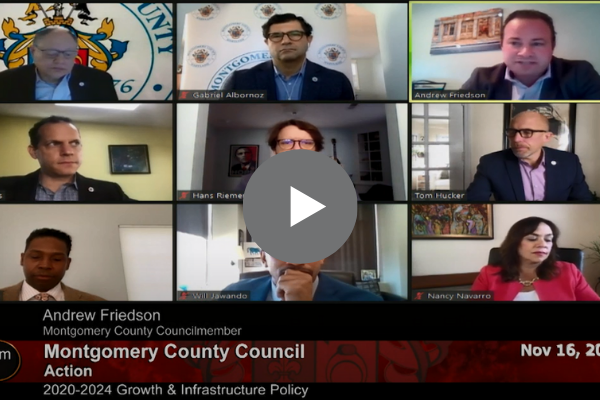
The Council this week formally approved an updated Growth and Infrastructure Policy, one of the most consequential ways we can boost our County’s economy, address our housing affordability crisis, and secure resources to build schools and transportation infrastructure.
Over the course of 19 committee and full Council work sessions and numerous meetings with residents and advocates, we crafted a policy that I’m proud to say is better aligned with our smart growth priorities and will make Montgomery County more affordable for new residents, more attractive to new businesses, and more competitive in the region. By making some significant changes supported by community stakeholders and refined data, we’ve made clear we’re putting up a welcome sign to our County where there was previously a wall:
-
The Council unanimously supported my proposal to end the failed housing moratorium policy countywide. The moratorium policy, which prohibited all residential construction if schools in certain areas were over capacity, was meant to drive additional investment to alleviate school overcrowding. Though in reality, it deprived the County of the very tax revenue needed to build those school projects while failing to stop the overcrowding, which is overwhelmingly caused by natural turnover in existing housing. It was an outdated policy that unnecessarily pitted existing residents against new residents.
-
We replaced the housing moratorium with a more precise and data-driven approach called a Utilization Premium Payment or UPP. Those who seek to build in areas with schools over capacity will still be able to create the housing we need to address the crisis. But they will have to pay, and pay more, based on the extent to which a local school or cluster is overcrowded. This allows us to generate additional revenue for school construction projects without preventing the new housing we clearly need.
-
Better aligning impact taxes with the actual impact projects will have on infrastructure and making Montgomery County more competitive in the region is a significant victory in this policy that we were able to achieve thanks to refined, location-specific data.
-
We prioritized smart growth by establishing new desired growth areas. We crafted new ways to encourage private-sector development in areas that already have, or will soon have significant transit infrastructure such as Metro, the Purple Line, and Bus Rapid Transit. This greater emphasis on livable, walkable housing and job centers will allow us to build a more environmentally sustainable and modern County better equipped to attract new residents and businesses.
-
For the first time, we incorporated Vision Zero principles into this policy. By shifting our focus from how fast drivers can travel through an area to the types of road, sidewalk, bike lane, and crosswalk designs that are best for all road users, we’ll start directing more transportation investments to projects that actually prioritize people’s safety.
Thanks to all who weighed in over months of work to help create a policy that allows us to grow in the right places and in the right ways while making our community more welcoming and attractive to new residents, new businesses, and new investment.
|